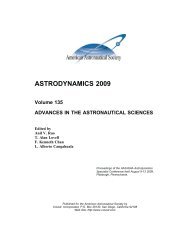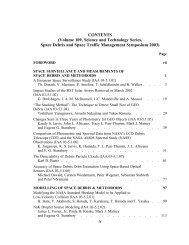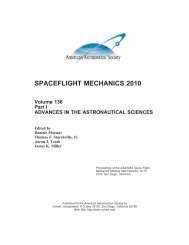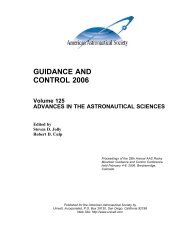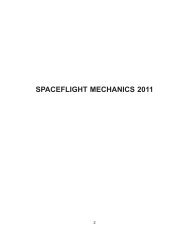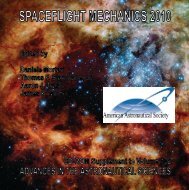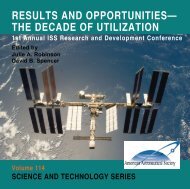information. - Univelt
information. - Univelt
information. - Univelt
- No tags were found...
Create successful ePaper yourself
Turn your PDF publications into a flip-book with our unique Google optimized e-Paper software.
AAS 12-044GPS AT GEO: A FIRST LOOK AT GPS FROM SBIRS GEO1 *Lee Barker † and Chuck Frey ‡On May 7, 2011, Lockheed Martin successfully launched the first of a new seriesof Space-Based Infrared System (SBIRS) satellites, SBIRS GEO1. SBIRS is intendedprimarily to provide enhanced strategic and theater ballistic missile warning capabilities.Part of the SBIRS GEO1 design is the inclusion of a dual frequency GPS receiver tosupport spacecraft navigation requirements. Launch of GEO1 is significant in that itmakes use of GPS in the geosynchronous orbit regime, providing a unique look at theGPS environment, expectation of performance, and new challenges in GPS applicationsas seen from above the GPS constellation.New user navigation accuracy and robustness requirements for GEO satellites havespurred interest in developing GPS navigation systems designed to operate in the sparsemeasurement environment. Understanding that environment is key to designing a successfulsystem.Several published papers have described the well understood geometric constraintsof the GPS system when operating receivers above the GPS constellation. A few operatorshave reported on actual data collected by receivers operating at or above the GPSconstellation. Finally, several papers have been authored regarding proposed systemsshowing simulation results for high altitude GPS based navigation systems. These simulationresults are based on modeling assumptions that are critical to the analysis. SBIRSGEO1 data offers the first look at actual observations from GEO, and an opportunity tovalidate or improve upon models.The purpose of this paper is to present and discuss observations, postulate phenomena,and identify areas where future research or work would be useful in the exploitationof GPS in the geosynchronous orbit environment. This paper will (1) briefly summarizesome earlier work in the use of GPS above the terrestrial and LEO regime, (2)present and discuss analysis of observed GPS signal from the GEO regime. These observationsinclude a look at ionosphere delay as seen from GEO, GPS L1 antenna groupdelay as seen from large angles off the GPS satellite beam center, and GPS signalstrength at GEO relative to link predictions. [View Full Paper]* © 2010 Lockheed Martin Corporation. All Rights Reserved. This paper/material is released for publication onlyto the American Astronautical Society in all forms.† Lockheed Martin Space Systems Company, Sunnyvale, California 94089, U.S.A.‡ Lockheed Martin Integrated Systems and Global Solutions.20



